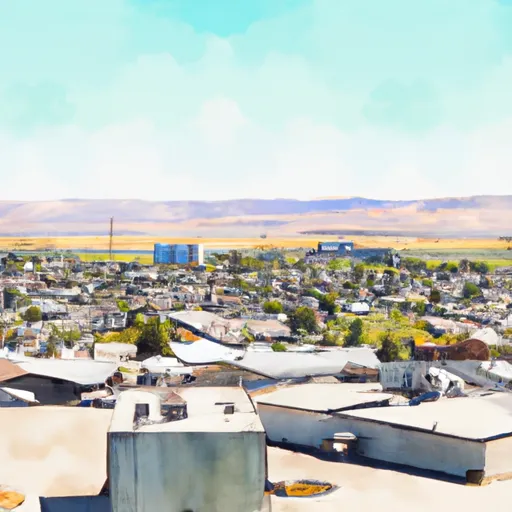-
 Snoflo Premium
Snoflo Premium
Get unlimited access to all our content
With no Ad interruptions! - Start Your Free Trial Login with existing account
Hinkley
Eden Index
Climate
8.4
•
Recreation
2.5
•
Community
•
Safeguard
4.2/10

Hinkley, California is a small unincorporated community located in the Mojave Desert region of San Bernardino County. Known for its arid climate, Hinkley experiences hot and dry summers with average temperatures exceeding 100°F (38°C) and mild winters with temperatures ranging from 50-70°F (10-21°C). The area receives very little rainfall, averaging only around 5 inches per year.
Hydrologically, Hinkley is primarily influenced by the Mojave River, which flows nearby. However, the groundwater in the region has been of concern due to the presence of hydrology constituents such as chromium-6, a toxic metal compound. This issue gained significant attention through the legal and environmental case made famous by the movie "Erin Brockovich."
Despite the challenges, Hinkley offers some outdoor recreation opportunities. The nearby Mojave National Preserve provides opportunities for hiking, camping, and wildlife viewing. Visitors can explore vast desert landscapes, unique geological formations like Kelso Dunes, and historic sites like the Kelso Depot. Additionally, the Barstow BLM Field Office offers off-road vehicle areas for enthusiasts to enjoy desert trails and sand dunes.
What is the Eden Index?
The Snoflo Eden Index serves as a comprehensive rating system for regions, evaluating their desirability through a holistic assessment of climate health, outdoor recreation opportunities, and natural disaster risk, acknowledging the profound impact of these factors on livability and well-being.
Climate Health Indicator (CHI): 8.4
Hinkley receives approximately
125mm of rain per year,
with humidity levels near 73%
and air temperatures averaging around
18°C.
Hinkley has a plant hardyness factor of
8, meaning
plants and agriculture in this region tend to thrive here all year round.
By considering the ideal temperature range, reliable water supplies, clean air, and stable seasonal rain or snowpacks, the Climate Health Indicator (CHI) underscores the significance of a healthy climate as the foundation for quality living.
A healthy climate is paramount for ensuring a high quality of life and livability in a region, fostering both physical well-being and environmental harmony. This can be characterized by ideal temperatures, reliable access to water supplies, clean air, and consistent seasonal rain or snowpacks.
Weather Forecast
Streamflow Conditions
Northern Mojave
Area Rivers
Northern Mojave
Snowpack Depths
Northern Mojave
Reservoir Storage Capacity
Northern Mojave
Groundwater Levels
Recreational Opportunity Index (ROI): 2.5
The Recreational Opportunity Index (ROI) recognizes the value of outdoor recreational options, such as parks, hiking trails, camping sites, and fishing spots, while acknowledging that climate plays a pivotal role in ensuring the comfort and consistency of these experiences.
Access to outdoor recreational opportunities, encompassing activities such as parks, hiking, camping, and fishing, is crucial for overall well-being, and the climate plays a pivotal role in enabling and enhancing these experiences, ensuring that individuals can engage in nature-based activities comfortably and consistently.
Camping Areas
| Campground | Campsites | Reservations | Toilets | Showers | Elevation |
|---|---|---|---|---|---|
| Owl Canyon | None | 3,064 ft | |||
| Adelanto City Park | 21 | 2,891 ft | |||
| Mojave Narrows Regional Park | 69 | 2,749 ft |
Nearby Fishing
Catastrophe Safeguard Index (CSI):
The Catastrophe Safeguard Index (CSI) recognizes that natural disaster risk, encompassing floods, fires, hurricanes, and tornadoes, can drastically affect safety and the overall appeal of an area.
The level of natural disaster risk in a region significantly affects safety and the overall livability, with climate change amplifying these risks by potentially increasing the frequency and intensity of events like floods, fires, hurricanes, and tornadoes, thereby posing substantial challenges to community resilience and well-being.
Community Resilience Indicator (CRI):
The Community Resilience Indicator (CRI) recognizes that education, healthcare, and socioeconomics are crucial to the well-being of a region. The CRI acknowledges the profound impact of these elements on residents' overall quality of life. By evaluating educational resources, healthcare accessibility, and economic inclusivity, the index captures the essential aspects that contribute to a thriving community, fostering resident satisfaction, equity, and social cohesion.

